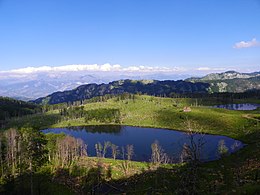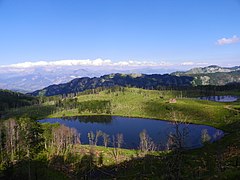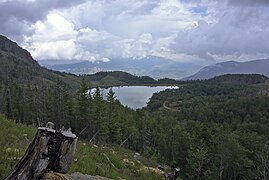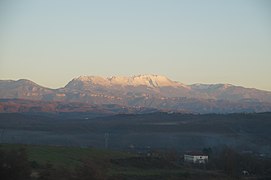Lurë-Dejë Mountain National Park
| Lurë-Dejë Mountain National Park | |
|---|---|
| Parku Kombëtar Lurë-Mali i Dejës | |
 View of Lake Kallaba | |
| Location | Dibër County |
| Nearest city | Peshkopi |
| Coordinates | 41°48′0″N 20°14′0″E / 41.80000°N 20.23333°E |
| Area | 19,288.88 hectares (192.8888 km2) |
| Designated | 21 November 1966 |
| Governing body | National Agency of Protected Areas |
Lurë-Dejë Mountain National Park (Albanian: Parku Kombëtar "Lurë-Mali i Dejës") is a national park in northeastern Albania, spanning an expanded area of 202.42 km2 (78.15 sq mi) since 2018 by encompassing the entire section of Kunora e Lurës, former Zall-Gjocaj National Park, and Dejë Mountain. The park was originally established in 1966 to protect the various ecosystems and biodiversity as Lura National Park. The altitude vary from 1,500–2,300 m (4,921–7,546 ft).[1] The International Union for Conservation of Nature (IUCN) has listed the park as Category II. Nevertheless, it is described as an important Bird and Plant Area, because it supports significant bird and plant species.[2][3]
Geography[edit]
In behalf to a great variability in elevation, Lurë-Dejës Mt National Park is densely populated in vegetation. Higher plant life consists mainly of both coniferous and deciduous trees, particularly around the shores of the lakes. The most common tree native to Lurë is the european beech along with silver fir, black pine, red pine and bosnian pine. Especially protected is the balkan pine, which is threatened with extinction and only common in the west of the Balkan Peninsula. The southern section of the park has a meadow of multicolour flowers and several coniferous trees, which is called the Field of Mares, offering pristine views over the landscape. In terms of phytogeography, the park falls within the Pindus Mountains mixed forests terrestrial ecoregion of the Palearctic Mediterranean forests, woodlands, and scrub biome.
Flora and fauna[edit]
The park shelters numerous species. Most important wildlife inhabiting the park includes the european brown bear, eurasian lynx, eurasian wolf, european pine marten, roe deer and western capercaillie.[4] Small mammals include the red squirrel and edible dormouse.[5] The twelve glacial lakes within the national park were formed during the ice age.[citation needed] They are located in the northeastern part of the nation in the Dibër County at an elevation between 1,200 and 1,500 m (3,937 and 4,921 ft). Each lake carries a name associated with its most characteristic feature.
Zall Gjoçaj, part of the expanded park, is an intensively fissured and mountainous landscape with a great variety of natural features including valleys, glacial lakes and dense forests without human intervention. Elevations in the area vary from 600 metres to over 2,000 metres above the Adriatic.[6] The geomorphological conditions of the region reflects the dynamic geological history, tectonic movements and erosive activity of the rivers flowing through the park.
Most of the area is covered by a mixture of beech, fir, pine, ash and maple trees growing on limestone and dolomite.[7] The park's woods are important because they provide shelter for numerous fauna. Most notable amongst them is the brown bear and grey wolf.[8][9] Other large mammals include lynxes, roe deers and birds such as the golden eagle.[10][11]
According to Albanian poet Gjergj Fishta, "Him/her who has not seen Lura, he/she has not seen Albania", meanwhile British renowned traveler Edith Durham has been quoted as follows: "When I came up the Qafë Lurë, I saw such a beautiful field, that I had never seen in any place of the Balkans".
Post-communism[edit]
Following the fall of communism in the 1990s, the area suffered massive deforestation from illegal logging and forest fires that severely affected ecosystems. It is estimated that as much as 50% of the original Lura National Park has been destroyed. In 2014, the Government of Albania launched a controversial rehabilitation campaign including reforestation, roadwork, and the putting of new signs.[12][13]
Local stakeholders have criticized the project as merely superficial. In the meantime, local non-governmental organizations such as Ecovolis are trying to revitalize the park by planting of trees and removing debris around the lakes, some of which are drying up. Nature is also helping by naturally spreading seeds of new trees which are growing at different areas of the park.[citation needed]
Accommodation consists of several family run hotels and guesthouses near the park in Fushë-Lurë. The area around Lura features traditional tower houses, the once industrial mining town of Kurbnesh, Ottoman mosques, and a recently renovated Catholic Church. The region is also home to Albanian Independence signatory Dom Nikollë Kaçorri.[citation needed]
In May 2002, Joseph Limprecht who served as the US Ambassador to Albania died from a heart attack, at the age of 55, while visiting Lure National Park.[14]
Outlook[edit]
In 2018, the park was expanded and renamed Lurë-Mt Dejës National Park to include former Zall-Gjocaj National Park for a total coverage area of 20,242 ha. The Albanian government has outlined a plan that would turn the area into an agritourism hot-spot under the 100 Villages Initiative, consisting in the renovation of traditional tower houses, and the reconstruction of the road connecting the park with Rreshen and the A1 motorway. Construction works for the latter started in late 2021 with the widening and stabilization of the existing road structure.
Reforestation[edit]
In 2019, a number of local NGOs such as Co-Plan and North Green Association in collaboration with local stakeholders planted 1000 new trees inside the protected area.
In 2020, GIZ Albania undertook the planting of 7000 trees in Lurë.[15]
Since 2021 a project called Trees for Lurë planted 22793 trees within the area of the national park, restoring 15.22 ha of the forest. In 2022, Trees for Lurë established tree nursery in Fushë-Lurë and started growing saplings locally, planting first 1081 locally grown trees during 2023 planting season.[16]
However, the future of the expanded national park is being threatened by the construction of hydro electric power plants in Zall-Gjocaj that would further cripple the already fragile ecosystem of the area.[17]
Gallery[edit]
-
Liqeni i Kallabës. Devastation from illegal logging can be clearly seen
-
Liqeni i Lurës
-
Liqeni i Madh from the top
-
Liqeni i Madh
-
View of the lake
-
Zall-Gjocaj
-
Dejes Mt
-
Panorama
See also[edit]
- Protected areas of Albania
- Geography of Albania
- Lura Lakes
- Sope Lake, Kacnise Lakes (Liqenet e Kacnise) along Balgjajt Mt near Bulqize
- Korab-Koritnik Nature Park
- Tourism in Albania
References[edit]
- ^ "Lura Geopark Albania" (PDF). progeo.ngo. p. 2.
The most widespread trees in this forest is beech, which begins from 900-1000m above the sea level up to the most upper level of the forest (1900-2000m).
- ^ BirdLife International. "Lura". datazone.birdlife.org.
- ^ IUCN, World Wide Fund for Nature, Plantlife. "Important Plant Areas of the south and east Mediterranean region" (PDF). portals.iucn.org. p. 75.
{{cite web}}: CS1 maint: multiple names: authors list (link) - ^ "Lura National Park". akzm.gov.al.
Large protected mammals as bear (Ursus arctos), wolf (Canis lupus), lynx (Felis lynx), chamois (Rupicapra rupicapra), roe deer (Capreolus capreolus), among birds we highlight the presence of the wild turkey ( Tatrao urogallus ) and eagles (Aquila chrysaetos).
- ^ University of Tirana. "Small terrestrial mammals of Albania: distribution and diversity (Mammalia, Eulipotyphla, Rodentia)" (PDF). zookeys.pensoft.net. Tirana.
- ^ University of Durrës. "Zhvillimi i turizmit malor ne Shqipëri" (PDF). uamd.edu.al (in Albanian). p. 28. Archived from the original (PDF) on 2021-04-14. Retrieved 2019-01-17.
- ^ World Wide Fund for Nature. "Ancient Forests in the Northern Mediterranean: Neglected High Conservation Value Areas" (PDF). mansourian.org. p. 35.
- ^ "On the status and distribution of the large carnivores (Mammalia: Carnivora) in Albania" (PDF). catsg.org. p. 2.
- ^ "On the status and distribution of the large carnivores (Mammalia: Carnivora) in Albania" (PDF). catsg.org. p. 4.
- ^ "MENAXHIMI I PARQEVE KOMBËTARE" (PDF). eurosai.org (in Albanian). p. 46.
- ^ "National Park "Zall-Gjoçaj"". Retrieved 29 December 2022.
- ^ "2 million trees for the Lura Park". top-channel.tv. 10 June 2014. Archived from the original on 7 April 2016. Retrieved 16 July 2017.
More than 2 million trees will be planned in 300 hectares. The General Secretary at the Ministry of Environment, Alqi Bllako, declared that the Ministry has contacted two private companies which will pave 18 kilometers of road within two years, rehabilitate the area and clean the lakes.
- ^ "Initiation of Lura National Park rehabilitation and reforestation project". ata.gov.al. 14 June 2014. Archived from the original on 12 November 2016. Retrieved 11 November 2016.
Rehabilitation of Lura National Park aims to create opportunities for sustainable tourism development in the area, provide employment opportunities for local residents, aiming to minimize the illegal pressures on natural resources of the area and returning the balance of rural tourism development, in view of the natural resources and products offered by the area.
- ^ "U.S. ENVOY TO ALBANIA DIES – Orlando Sentinel".
- ^ "FOTO-Ripyllëzimi i zonave të mbrojtura/ Nis mbjellja e 7 000 fidanëve në Lurë - ATSH -". 23 November 2020.
- ^ "Trees for Lurë reforestation project". 14 December 2023.
- ^ "Financing for hydropower in protected areas in Southeast Europe: 2018 update" (PDF). European Nature Heritage Foundation. March 2018. Retrieved 29 December 2022.
Further reading[edit]
- Hanbury-Tenison, Robin. 2009. Land of Eagles: Riding Through Europe's Forgotten Country. Through Lura National Park
- Elsie, Robert. 2015. The Tribes of Albania: History, Society and Culture. The Tribe of Lura










